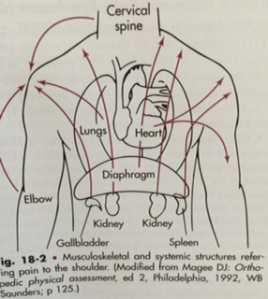I’ve been looking at the above image for years. You have too. There is almost nothing left to notice…but I just noticed how hollow the homunculus is.
There is no representation of your
organs anywhere to be found! Are you trying to tell me that I cannot “feel” the inside of my body?!(in the simplest sense of the word)
I’m walking around with a brain and a liver and a spleen but … how do I feel them? It seems as though I can feel them, but if I really search for them in my mind… nope, not there.
Let’s start here:
We have all seen pictures of referred pain like this.
They seem overly complex and confusing. “You mean my kidney can refer and make my shoulder hurt?” Well, yes. “You mean my abdominal aorta can make me feel low back pain?” Well, yes.
The common version of explaining this is that the general visceral afferent nerves that innervate these organs (heart for example) hitch a ride with peripheral somatic sensory nerves and the signals get mixed in the dorsal horn of the spinal cord (mimicking shoulder pain). Yes that’s true, but the real reason you feel your shoulder during a heart attack is that you just can’t feel your heart. There is no place in your brain to alert yourself to heart danger, peripheral sensors or no!
It’s not that your heart made your arm hurt, it’s that we are incapable of feeling it any differently. We are limited.
If a tree falls in the forest and no one is there to hear it, does it make a sound? If a duodenum screams out in irritation, is there a receptor area to take the input?
So cerebral body sensory areas are stimulated via this peripheral phenomenon… and we gain filtered information about our visceral systems. We must make inferences. We need to correlate clusters to get an idea of our current state.
We have no first hand information about our innards. Crazy.
We are indeed hollow, a deuterostome, a tube…sensorily speaking.
-Matt D




Hi Matt
I am a sports physiotherapist from Melbourne, Australia asking the same question, massively interested in neuroscinece and pain science too. I am glad you made a good attempt to acknowledge the problem of the “empty homunculus”..
There is a main point I think you might have missed, see what you think :
The somato-sensory homunculus was discovered by probing the brain with electrodes and asking patients where they felt it, or observing a motor response.
Now, when it comes to organs, as you say, they cant be consciously felt (that may be true), but a homunculus doesn’t rely on that. Somewhere in the brain or central nervous system is the representation of each organ, either as a network or cluster. And i suggest that by probing that part of the brain (eg with an electric probe) at least a “motor” response could be achieved in that organ, eg to (secrete more gastric juices). I suspect that organ representations are deeper than the cortex and spinal cord, due to their “primitive brain” nature. If there were not organ homunculus’ then they could not be controlled by our nervous system. I recently watched a educational video on the enteric nervous system: If there is an enteric nervous system, then there must be a location (homunculus) for it.
So the only way of discovering them would be to poke around with an electrode (I’m not volunteering!)
(I think you might have accidentally crossed the ideas of homunculus with dermatomes at some point.)
regards,
ChrisM
LikeLike
Thanks Chris- excellent point… Viscera certainly is innervated and controlled,etc by our “animal brain” etc.
You’re making me think! Perhaps it’s that it doesn’t cone to our conscious level… or when it does, the only way it can is through a crossover to the somatosensory homunculus…
Thanks for the additional input, it’s an excellent subject to ponder..
-Matt D
LikeLike
Hi Chris and Matt,
I am a psychologist from Germany and interested in the following:
Is there a neuronal representation of the pancreas and the insulin producing b-cells in the homunculus?
Greatly appreciating your help,
Michael
LikeLike
Not that I know of!
Of course, this discussion of homunculus is geared towards our conscious sensation… there are certainly monitors of our body’s systems that occur automatically without our knowing.
LikeLike
Pingback: Top PTBT Posts of 2015 | PTbraintrust
Matt, ENT doc here. Considering neuroplasticity and homunculus issues re: pain with surgery (or relief of pain).
I recall being told/reading that the referred pain issues are overwhelmed by massaging the actual region. E.g., the pain of a “sinus headache” refers pain (likely migraine actually) to the forehead and temples but massaging those areas can overcome the pain as an ACTUAL stimulus to a homunculus site is stronger than a referred sensation.
I cannot find a reference to document this though. I did not make it up did I? Do you know a reference for this thought? Thanks
LikeLike
Actual stimulation vs referred sensation… fascinating! I do mot know of any studies, but traditional A-beta stimulation and Gate Control Theory likely play a role in findings like that.
Thanks for the comment, that gets me thinking Stephen
LikeLike
This may explain things … “Hollow Inside” (The Buzzcocks, 1979)
LikeLike
Pingback: A Year In Review: II | PTbraintrust